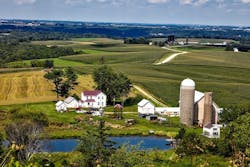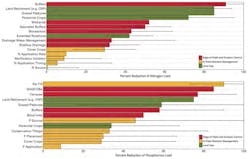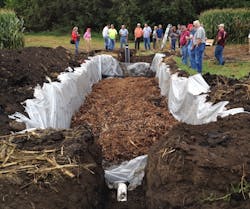The Watershed-Based Approach to Address Non-Point Source Nutrients
About the author:
Tyler Marshall is a principal environmental engineer in the Iowa City office of Stanley Consultants, performing civil and environmental engineering projects since 1998.
|
Read the other articles in this series
|
Major U.S. river ecosystems such as the Mississippi are both suffering from and contributing to aquatic dead zones caused by algae blooms in connection with fertilizer runoffs from agriculture. Although the U.S. EPA has not imposed numerical standards that would create enormous financial burdens on local governments and industry, the agency has followed the issue closely and the potential for tougher standards exists.
While many municipalities, industrial water users, farmers and water districts are already tackling the nutrient problem, stricter EPA regulations would force every owner to join them at some financial pain. There are two approaches to reduce nutrients—mainly phosphorous and nitrogen-based fertilizers—that wash into river ecosystems from farms. The two approaches are treatment at the point where water is treated or used, such as an industrial plant or municipal water treatment plant; or non-point treatments that involve using natural techniques to reduce nutrient releases.
In the last of this three-part series, we look closer at non-point treatments in the farms, fields and wetlands where an investment—be it from federal, state or local sources, charities or land owners themselves—is more effective and cheaper than building a new water treatment plant.
Although nutrient reduction costs will vary by method, climate and the type of land, non-point methods are in the range of 10 to 25% of point source nutrient removal costs, and non-point methods are natural and offer other benefits as well.
A Perfect Stew – Water, Sunlight, Carbon Dioxide & Inorganic Nutrients
At the most basic description, algae are plants. Algae can take many different forms and inhabit many different ecosystems, even living on land. They can range in size from microscopic organisms to large varieties such as seaweed.
The types of algae that create the toxic algae blooms on our lakes and streams typically is a green or blue-green variety of the micro- scale algae organisms. They can reproduce very quickly and need only sunlight, water, carbon dioxide and a few inorganic nutrients such as nitrogen and phosphorus to grow. An abundance of these growth resources ripens conditions for explosive growth, resulting in an algae bloom.
The excess nitrogen and phosphorus from sources such as topsoil erosion or fertilizer runoff supply an overabundance of what ordinarily might have been a limiting factor in algae growth. When the algae die off as the nutrients are consumed, the decaying matter degrades and consumes dissolved oxygen from the water, which can lead to fish kills. Additionally, some varieties of algae give off toxins (microcystin) as they decay which are toxic and potentially deadly to humans and other mammals that contact the water.
What can be done?
The most efficient methods for controlling algae blooms is to remove the nutrients at their source. A tremendous amount of effort has been expended by states, universities, federal agencies, farm industry groups, landowners and other stakeholders to develop programs that look deeper into a wide range of watershed-scale changes that can address non-point sources of nutrients.
The most prevalent nutrient reduction practices fall loosely into three categories — in-field nutrient management, land use strategies and erosion control, or edge-of-field practices.
In-field Nutrient Management
Historically, the objective of in-field nutrient management best practices was saving money and maximizing crop yields. Better incorporation of fertilizer and management of application rates means less waste. Less waste saves money, but it also means significant reduction in nutrient runoff. Better management of application rates and methods means that a higher proportion of nitrogen is taken up by plant roots rather than washing off through surface runoff or down through the soil profile to underlying drain tiles.
No-till farming techniques protect the soil by leaving crop residue on the soil surface and also improve soil health. However, this improved soil structure and cover increases the soil’s moisture storage capacity, which then reduces soil erosion. Reduced erosion means reduced phosphorus released to streams and rivers.
The use of winter cover crops is a more recent trend in agricultural best management practices. A cover crop is something that is planted after the primary cash crop, such as corn or soybeans, is harvested. This is typically not a crop that can be harvested for monetary gain but instead is planted solely for the environmental benefits. They are most commonly quick-growing and cold tolerant grains or grasses.
One of the biggest barriers to widespread use of winter cover crops is the significant cost for seed, equipment and fuel for planting cover crops. However, when one considers the long-term health of the soil, the increased crop yields will generally more than offset their cost.
The benefits of cover crops include things such as reducing erosion and associated phosphorus runoff, absorbing nitrates that are in the soil, improving soil health, and by providing dense ground cover may also suppress noxious weed growth in fields.
Land-use Practices
Among the most effective methods for reducing nitrogen and phosphorus loading to a watershed is to reduce the number of acres planted in high-intensity row crops. By converting row cropped acres to non-cash crop uses, fertilizer application is no longer needed, soil erosion is greatly reduced, and soil health and structure can improve dramatically.
This conversion can be short term or for many years. Examples of short-term conversions might be a rotation of land use which periodically utilizes row crop land instead for pastureland. This can make good financial sense as well because the price of traditional cash crops can vary widely from year to year. During times when production costs are high and crop prices are low, there can be an economic case to be made for conversion to cattle grazing pastures.
A common program for longer-term conversion of row-crop land is enrollment of less productive acreage into land retirement programs such as the United States Department of Agriculture’s Conservation Reserve Program (CRP). This program pays landowners a yearly rental payment in exchange for converting environmentally sensitive land away from agricultural production and planting species that will improve environmental quality. Contracts for land enrolled in CRP are generally 10- to 15 years. The goal of the program is to restore land cover which in turn improves water quality, reduces soil erosion and restores wildlife habitat.
Erosion Control and Edge of Field
This type of practice generally represents ideas that serve to remove nutrients from field runoff rather than reduce the source. These practices tend to have the highest amount of nutrient reduction relative to the size of physical footprint. Many of these practices can also be modified or scaled down to provide sediment and nutrient control for urban runoff or industrial sites as well.
Water and sediment control basins (WASCOBs) and grade stabilization structures are structural erosion-control practices already commonly in use for sediment control for construction sites. They can be sized to accommodate a wide range of flow rates. When located at the downstream end of drainage form a field, they can reduce the loss of soil-bound phosphorus by up to 85 percent.
Engineered wetlands are a very effective edge of field practice for reduction of nitrogen from field drainage. Significant nitrogen runoff concentration reductions can be achieved if runoff were routed through a wetland prior to entering a stream. These wetlands also can serve multiple purposes, with restoration of wildlife habitat, public recreation, flood volume reduction or even enrollment for credits into a wetlands mitigation bank in certain cases.
Bioreactors could be installed in-line with existing drainage tiles near their outlet in order to reduce nitrogen. Bioreactors come in many forms, but the most common type is a lined trench filled with wood chips, which serve as a substrate for bacterial growth. The bacteria then remove the nitrogen contained in the flows entering the reactor. The wood chips would need periodic replacement as bacterial decomposition occurs.
Vegetated buffer strips located along the edge of fields act like a filter, capturing sediment and phosphorus. They will also remove nitrogen, as permanent buffer vegetation with deep roots use a portion of the nitrogen being carried away in field runoff. Vegetated buffers can be enhanced with a buried water distribution system that diverts drain tile flows to irrigate the roots of the permanent buffer vegetation, resulting in enhanced nitrogen uptake. With this modification, the buffer strip would be referred to as a saturated buffer.
Soil erosion from meandering stream banks is a potentially significant source of phosphorus. This type of erosion can be a source of sediment and phosphorus, especially in areas where streams have been artificially straightened, as the stream tries to regain its natural sinuous shape. Since each stream is unique, there is no single best form of stream bank protection.
In some cases where there are high velocities, heavy man-made reinforcing, such as large riprap is necessary to resist the energy of the flow. However, for smaller streams there are lower cost approaches modeled after naturally erosion-resistant features. Slopes can be reinforced by planting grasses and trees that have deep and dense root structures to lock soil in place. This can be enhanced with the use of soil reinforcing fiber mats, placement of tree root balls to serve as energy dissipators and anchoring bundles of willow cuttings to both provide scour resistance and grow new willow saplings with their anchoring roots.
Individual practices are often not enough by themselves to meet nutrient reduction goals. However, many of the practices are complimentary and their removal efficiencies can be stacked. For instance, WASCOBs designed for phosphorus removal can be sited upstream of an engineered wetland to enhance the functionality of the wetland by preventing unwanted sediment buildup in the wetland.
At the same time, phosphorus removal serves as a welcome additive to removing nitrogen from wetlands, removing key ingredients of harmful algae blooms. This idea can be taken even farther upstream by adding buffer strips at the edge of source areas.
Identify Project Sites
Under-utilized land owned by a community or a local industry could be repurposed for engineered wetlands or bioreactor construction, which would reduce both nitrogen and phosphorous. These types of projects can work with other programs, such as wetlands banking, stream restoration credits or local flood mitigation. Engineered wetlands and stream buffers also can be designed to provide a variety of recreation, habitat conservation, fishing or hunting opportunities.
Farmers face pressure to produce as many bushels of grain as possible, given the land available to them. It used to be a common practice to reshape wetlands to drain them or install drainage tiles to reduce the soil moisture and creating tillable land. Low-lying farmland is often not reliably profitable for crop production. These fields often contain formerly converted wetlands.
The sites could be converted to engineered wetlands by redirecting drainage tiles and swales and controlling the discharge of water. And finally, projects can serve dual purpose. Flood mitigation projects, streambank stabilization projects, habitat or recreation enhancement projects can all be registered for nutrient credits.
The most effective site selection and design will incorporate as many complimentary practices as possible, with the multiple layers of nutrient removal adding together for a multiplicative effect of nutrient reduction.
Technology
Technology can also assist in identifying candidate project sites. Drone technology can be used to conduct flyovers of lowland sites in order to create high-precision site models. The types of sensors that the drones can deploy include light detection and ranging (LIDAR) to generate sub-inch accuracy site surface models and identify site drainage features even in heavily forested conditions.
Magnetometers identify locations of agricultural drainage tiles. And thermal imaging sensors pinpoint the locations of different species of vegetation, such as invasive species which would diminish the functioning of a healthy wetland ecosystem. Aerial drone technology has radically reduced the time and expense of assessing the potential viability of a site for installation of conservation practices such as engineered wetlands.
Success Stories
Case studies on successful nutrient reduction programs are available in the EPA’s Gulf Hypoxia Task Force site. Stanley Consultants has also been involved with similar projects.
F.W. Kent Park, Iowa - The 26.5-acre lake was degraded due to an influx of sediment, nutrients and bacteria from its 687-acre watershed. Stanley Consultants and a subconsultant designed five catch basins in the park to collect prevent runoff from reaching the lake. Two bio-retention cells at the boat ramp parking area were also installed. Designs were refined using water quality modeling results to effectively reduce sediment loads by an average of 87 percent. Sediment and nutrients on the lake bottom were dredged. In early 2019, the popular lake was restocked with fish and opened to the public. The improvements cost $2.5 million.
Railroad property, nutrient credit exchange, Iowa – A railroad client needed to build an access road on nearby farmland to service and maintain its tracks. The farmer required the railroad to buy the entire 1,600-acre parcel for $1.5 million. The railroad company took advantage of nutrient reduction credits to make the deal profitable. It spent another $700,000 to design and construct a series of natural improvements such as a stream bank stabilization for several miles. Drones with sensors were used to identify tile drains that were removed so that the natural wetlands could reform. The wetlands credits alone will be worth from $2- to $2.5 million on the anticipated nutrient reduction credit exchange that is expected to be introduced in the state. Other credits such as the stream bank stabilization could also be worth significant dollars.
Pros & Cons
Farmers aren’t required to spend capital on these projects. Even with grants, farmers typically have to fund 25 percent or more of the costs. What’s their motivation for reducing nutrient runoff?
Engineered wetland, for example, starts at $100,000 and can easily be a $250,000 project; and it takes land out of production. Conversely, wetlands converted to crop land aren’t normally that productive. One could make the argument that while it costs money, you’re saving money you were wasting on money-losing crop land. With the sale of nutrient credits, it can be a revenue source. Every situation is different and must analyzed that way.
Farms can also benefit from reduced topsoil erosion, improved soil health, reduce the amount of fertilizer needed and potentially initiate carbon capture and watershed projects.
In Iowa, three example scenarios were developed that meet both the nutrient reduction objectives. Initial investment costs of the three scenarios range from $1.2- to $4 billion. Alternatively, annual costs, including initial investment and operating cost, range from $77 million per year to $1.2 billion per year, according to the Iowa Nutrient Reduction Strategy 2017-18 Annual Progress Report. Since 2011, farms have invested $171 million in projects that have received cost-share contracts through public conservation programs.
Strategy goals are to be met within 30 years, according to Iowa officials. Cover crop acres increased from an estimated 15,000 acres in 2011 to 760,000 in 2017. At least 10 million acres of cover crops are needed to meet Iowa’s goals. Similarly, the need for nitrogen-reducing wetlands is 5- to 10 million acres treated. There are 104,000 acres treated statewide so far.
Talk to an Expert
Some project sites or conservation practices may require additional permitting. Reach out to experts at the state, the United States Army Corps of Engineers, or a private consulting engineer who can help you understand the credits registration process and clear regulatory hurdles.
Conclusion
Nutrient reduction exchanges, such as the one in Iowa, may not be rolled out, but it is not too early to start identifying opportunities to take advantage of them once online. Projects which provide nutrient reductions can be entered into the tracking system now and will be eligible for the full program benefits and incentives once it is finalized. State funding for projects may be limited, so interested communities should start work early to identify possible projects, since funding may be in part on a first come, first served basis.
Read More Nutrient Loading & Algae Bloom Articles
- Read Part 1 of this series: Ever Increasing Algae Blooms & Dead Zones Threaten U.S. Waters & Aquatic Life—for more on algae blooms and how nutrient loading is part of their cause.
- Read Part 2 of this series: Iowa’s Innovative Approach to Nutrient Loading: The Nutrient Reduction Exchange for an understanding of Iowa's Nutrient Reduction Exchange.
- Managing Nutrient Pollution
- Cleaning the Chesapeake


